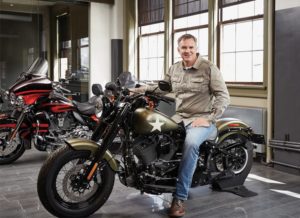In 24 years at Harley-Davidson, Matt Levatich and his wife have gone on plenty of motorcycle rides. What they haven’t done, is gone on a ride that was just the two of them. That’s changing today as the couple, having celebrated their 28th wedding anniversary on Sunday, leaves on a drip for the Upper Peninsula of Michigan.

Levatich brought these plans up during remarks at Scale Up Milwaukee’s Meet the Masters series not just as a personal anecdote, but because they also highlight an element of Harley’s mindset shift from building motorcycles to building riders.
A lot of effort and attention is paid to whether Harley-Davidson can attract new riders to ride motorcycles, but Levatich pointed out it’s important for the company to also focus on encouraging current riders to engage with the sport more.
“When people are thinking about riding more, they’re interested in the products, the gear, the experiences and the camaraderie so putting our emphasis on that helps the company unlock growth potential,” said Levatich, Harley’s president and chief executive officer.
He pointed out falling temperatures and the possibility of rain pushed the couple to take an extra interest in the latest gear and his wife was making a quick trip to a dealership Thursday morning to get a few things for the ride.
During a roughly one hour conversation with Scale Up Milwaukee executive director Elmer Moore, Levatich reflected on his career and the actions Harley has taken in recent years to adapt to changing demographics, a slowing U.S. motorcycle market and opportunities around the world.
“I would say right now we are romancing growth, we are courting growth, (but) we’re not growing,” he said, adding that since the economic downturn Harley has worked to strengthen its core capabilities.
The first areas of emphasis were manufacturing and product development, but the company is now turning to cultivating demand for its products.
“If we don’t have people riding, people won’t care about motorcycles,” Levatich said.
Moore pointed out most business coaches or consultants would advise against laying out a 10-year strategic plan like Harley did in early 2017, arguing it would amount to nothing more than a vision after having to adapt to changes in the market.
Levatich contended in the context of a 115-year-old company, a 10-year plan “is not that audacious.”
He also acknowledged it does function as a vision for the company supported by specific strategic targets. He also said Harley is reviewing the plan on a regular basis and would decide when public updates are needed.
“We felt this summer it was very important. There are a lot of people that are wondering ‘what’s going on at Harley?’” he said, noting U.S. sales have not been growing for the company or the industry as a whole.
In July, Harley announced a number of updates to its strategic plan, including entering new motorcycle segments, launching an electric motorcycle and enhancing its dealership network. The vision and goals remain the same for the 10-year plan, but the new five-year plan is about accelerating the strategies, Levatich said.
“The plan has a very exciting component of modernizing, not what we stand for, but how we show up,” he said.
At the core of the Harley brand is the idea of rebel or rebelling, he pointed out. For many people, that idea conjures concepts like “my way or the high hay” or “stick it to the man.”
“In a lot of cases, when people hear the word rebel … it has a negative connotation,” Levatich said. “We’re turning that into a positive connotation, what are you rebelling for?”
That change in thinking is part of the company’s conscious effort to be more inclusive, inviting and interesting to more people. So too is the identification of the company’s core values, concepts like freedom, strength, independence and self-expression.
Levatich said some of the things Harley is known for like a particular sound or loud exhaust pipes, are examples of how those concepts and the emotions connected to them show up.
“When we talk about product design we talk about how we want the customer to experience, not the attributes of the product like loud pipes,” he said.
“Those emotional goals are the foundation of product design and product development, they have manifested themselves in certain ways over the past 20 or 30 or 50 years, but they can manifest themselves differently,” he added.


